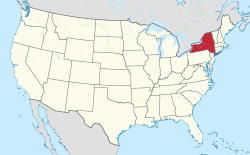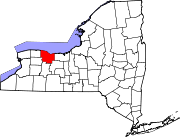Geography
Riga is in western Monroe County, 15 miles (24 km) southwest of downtown Rochester. It is bordered on the north by the town of Ogden, on the east by the town of Chili, and on the south by the town of Wheatland. The town is bordered on the west and southwest by the towns of Bergen and Le Roy in Genesee County. Interstate 490 crosses the town.
According to the U.S. Census Bureau, the town of Riga has a total area of 35.2 square miles (91 km2), of which 35.0 square miles (91 km2) are land and 0.3 square miles (0.8 km2), or 0.75%, are water. [2]
Demographics
Historical population| Census | Pop. | Note | %± |
|---|
| 1820 | 3,139 | | — |
|---|
| 1830 | 1,917 | | −38.9% |
|---|
| 1840 | 1,984 | | 3.5% |
|---|
| 1850 | 2,159 | | 8.8% |
|---|
| 1860 | 2,177 | | 0.8% |
|---|
| 1870 | 2,171 | | −0.3% |
|---|
| 1880 | 2,221 | | 2.3% |
|---|
| 1890 | 2,031 | | −8.6% |
|---|
| 1900 | 1,864 | | −8.2% |
|---|
| 1910 | 1,853 | | −0.6% |
|---|
| 1920 | 1,649 | | −11.0% |
|---|
| 1930 | 1,718 | | 4.2% |
|---|
| 1940 | 1,669 | | −2.9% |
|---|
| 1950 | 1,906 | | 14.2% |
|---|
| 1960 | 2,800 | | 46.9% |
|---|
| 1970 | 3,746 | | 33.8% |
|---|
| 1980 | 4,309 | | 15.0% |
|---|
| 1990 | 5,114 | | 18.7% |
|---|
| 2000 | 5,437 | | 6.3% |
|---|
| 2010 | 5,590 | | 2.8% |
|---|
| 2020 | 5,586 | | −0.1% |
|---|
|
As of the census [7] of 2000, there were 5,437 people, 1,969 households, and 1,518 families residing in the town. The population density was 154.6 inhabitants per square mile (59.7/km2). There were 2,018 housing units at an average density of 57.4 per square mile (22.2/km2). The racial makeup of the town was 97.26% White, 0.72% African American, 0.15% Native American, 0.74% Asian, 0.04% Pacific Islander, 0.09% from other races, and 1.01% from two or more races. Hispanic or Latino of any race were 0.92% of the population.
There were 1,969 households, out of which 39.1% had children under the age of 18 living with them, 64.9% were married couples living together, 9.1% had a female householder with no husband present, and 22.9% were non-families. 18.6% of all households were made up of individuals, and 7.6% had someone living alone who was 65 years of age or older. The average household size was 2.75 and the average family size was 3.15.
In the town, the population was spread out, with 28.3% under the age of 18, 6.1% from 18 to 24, 30.5% from 25 to 44, 25.6% from 45 to 64, and 9.6% who were 65 years of age or older. The median age was 38 years. For every 100 females, there were 99.2 males. For every 100 females age 18 and over, there were 93.5 males.
The median income for a household in the town was $58,842, and the median income for a family was $65,106. Males had a median income of $47,083 versus $31,202 for females. The per capita income for the town was $23,590. About 3.3% of families and 3.8% of the population were below the poverty line, including 2.3% of those under age 18 and 10.7% of those age 65 or over.
This page is based on this
Wikipedia article Text is available under the
CC BY-SA 4.0 license; additional terms may apply.
Images, videos and audio are available under their respective licenses.



